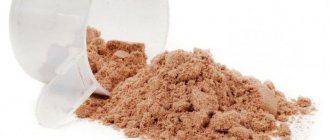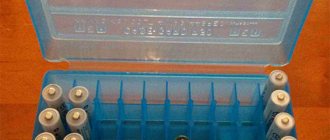It would seem that salt is a natural preservative that is mined from the bottom of salt lakes.
And what is the expiration date? But time limits appeared in accordance with the “Rules for the sale of certain types of goods”, which were approved by the Russian government. Now, when selling food products, it is necessary to indicate the production date and shelf life, among other information.
Shelf life
Experts say that salt does not lose its consumer properties for a long time. But they depend on storage conditions, the type of packaging material and various additives. Salt packaged in glass jars can be stored for 5 years, in plastic bags - 2-3 years, and about a year - packed in paper packs.
Why are such deadlines set? The fact is that table salt is very hygroscopic, capable of intensively absorbing moisture from the air. When stored for a long time, it cakes, dries out and turns into a stone monolith, difficult to destroy.
Dampness is the main enemy
Rice grains are placed in a container with salt. It absorbs moisture perfectly. Usually the rice is placed in a small textile bag. This method works well for salt shakers, but they usually put a couple of grains in them.
Add a couple of cloves of garlic to the salt. They also absorb moisture.
Sometimes salt is combined with starch. True, not everyone likes this flavor combination.
An absorbent desiccant in the form of a tablet or small granules in a bag is placed next to the jars of salt.
Looking at the color
According to the processing method, salt can be with additives (iodized, fluoridated) or without additives. According to quality, it is classified into grades: extra, highest, first and second. Fine and crumbly, like soft lake sand, salt of extra and highest grades should be pure white, while in the product of grades 1 and 2 the presence of dark particles is allowed, and the color of such salt can vary from white to gray with shades.
Photo: flickr.com
For culinary purposes, extra salt is better suited, but if you are going to pickle cabbage or cucumbers, then choose coarse salt - it will make the pickles appetizing and crispy. But iodized salt is not suitable for homemade preparations: cabbage, cucumbers, and mushrooms become bitter and soft from it.
By the way, iodized salt has a much shorter shelf life: if potassium iodide (potassium iodide) is used as an additive in its production, the salt with this component is suitable for use for 6 months, if potassium is iodic acid (potassium iodate), then 9 months. After these periods, the healing properties disappear, but this salt can be used as regular table salt. Iodine evaporates both when heated (therefore, you need to salt a ready-made dish with such salt), and when stored improperly: for example, if the salt has been soaked or has been in an open container for some time.
Sometimes even the simplest products spoil because they are stored for a long time in unsuitable conditions.
Even salt and sugar are the basic ingredients of almost all dishes. Let's consider, for example, a simple topic: the shelf life of iodized salt. Does it exist, what is it like and under what conditions does it operate?
What is iodized salt?
Iodized salt is the same as food salt, just additionally containing iodide or potassium iodate (the second option is now more often used). This product naturally replenishes the deficiency of iodine necessary for the body in those regions where this is especially important. Iodized salt thus serves as a prevention of widespread disease of endemic goiter.
For canning, non-iodized ones are usually used, since iodides lead to oxidation of products and contribute to their darkening. There is no harm from this, but from an aesthetic point of view, a regular kitchen one would be preferable for preparations.
Why is little iodine bad?
Depending on its severity, iodine deficiency can lead to both serious illness and cognitive impairment. In the first case, we are talking about the occurrence of goiter - an enlargement of the thyroid gland. Hypothyroidism, which then develops, affects the entire body and can cause a variety of problems - fatigue, weight gain, dry skin, swelling, cardiovascular disorders, muscle weakness, decreased potency, menstrual irregularities, psychosis and much more, even hypothyroid coma, the mortality rate of which exceeds 50 percent.
Lack of iodine during pregnancy is dangerous because it affects the development of the child’s nervous system and brain. It is known that even in a mild form, a deficiency of this element in the prenatal period can irreversibly affect the mental development of the child in the future. A slight iodine deficiency in childhood is minus 10 points from IQ. In this case, not only learning ability, for example, suffers, but also behavior. After the Chernobyl disaster, endocrinologists learned about another consequence of iodine deficiency: in this case, the thyroid gland is less protected from radiation and there is a higher risk of developing an oncological process in its tissues.
How long is it stored?
Regular salt - rock or refined - does not have an expiration date, that is, it can be stored as long as you like. After all, it itself is an excellent preservative that has been used for centuries.
Although on packages of “Extra” grade evaporated salt, not iodized, you can find an indicated shelf life of 2 years. This product also contains the anti-caking agent E536; perhaps the shelf life relates specifically to the action of this component. And, indeed, you may notice that such salt, unlike the usual salt in cheap cardboard packages, does not cake.
The only storage condition is dryness. With increased humidity, the salt first becomes cottony, the grains stick together and stop falling, and then the salt hardens into lumps and it becomes simply inconvenient to use - it is difficult to dose.
Iodized salt has a limited shelf life - no more than 6 months! There will be nothing left of the salt itself even after this period, but its iodization will disappear.
How to store?
Now salt is often sold not only in simple cardboard boxes, but in plastic containers with lids. The packaging itself is a kind of salt shaker - the lid has two opening modes: with small holes in order to add a small amount of salt to the product, and with large holes - it is convenient to salt dishes from it when cooking, when a dose of 1-2 tablespoons or teaspoons is required.
If you prefer to buy salt in a cardboard box, then pour it into your salt shaker and store it there. If you purchase slightly more expensive options with salt shaker packaging, then store them in it.
Tip: do not salt hot dishes when cooking with a salt shaker, so that steam from the boiling dish does not rise and enter the salt shaker. Place salt in your palm or spoon and then add salt.
Actually, that's all! The shelf life of salt will depend only on how carefully you keep it dry! Just buy iodized ones in limited doses so that you can use them before the expiration date or change the packaging every six months. You can find out more about why this is so in the article Does iodine have an expiration date?
Recommendations
Any housewife has this valuable product: in the kitchen or in the bathroom, it is extremely useful in everyday life:
- A hot saline solution will help get rid of the unpleasant smell of the sewer;
- You can remove mold using a salt mixture with lemon juice;
- If you add it to washing powder, colored items will stain less;
- If you sprinkle it on a red wine or grease stain, it will come off easier;
- You can refresh the appearance of apples by washing them in a saline solution. The skin will smooth out.
Sodium chloride is one of the most common means of traditional medicine: rinsing the nose with a solution of sodium chloride and soda saves from a runny nose, and the throat from a sore throat. Saline solution, like all known lithol or fat-based grease, fights joint dysfunction. Also used for purulent wounds, boils, inflammation after dental treatment, and for fungus. In addition, it is an excellent preservative.
Some interesting facts
- Iodine deficiency contributes to the development of mental retardation.
- In coastal regions, iodine is found in greater quantities in the soil and in products grown on it.
- Seafood also contains iodine.
- Prevention of iodine deficiency cannot be a one-time thing, it is required constantly, so iodized salt is an excellent solution.
- Sea salt cannot be a substitute for special iodized salt, because the iodine content in it is much lower.
What is the shelf life of salt?
- Salt is a chemically stable substance, its shelf life is unlimited, provided it is stored correctly (in a non-toxic place, of course, otherwise such salt cannot be used)
- The shelf life of salt is not limited, which is very pleasing, meaning it can be easily stored for future use.
But just don’t forget about proper storage so that moisture doesn’t get in.
Over time, the salt in the pack ceases to be free-flowing if it sits for a long time, but as soon as you lightly tap the pack with something, it again turns into a free-flowing product (I checked it myself).
- Salt keeps well, you can keep it for years, knowing. that it won't spoil.
If there is only dampness, it can petrify, but even after that it can be used, broken and that’s it.
I once had a kilogram of salt lying around and when we moved about five years later we found it and used it and everything was fine, the packaging was intact and in a dry place, it stayed there perfectly.
- The shelf life of salt is unlimited. This is written on the pack itself. But you still need to pay attention to the date of manufacture and storage conditions of this product.
It is worth remembering that if stored incorrectly (or the salt is stored for a long time), it turns into a lump - as if quot; Cementedquot; and ceases to be free-flowing.
So it’s not worth purchasing this product for use.
- The guaranteed shelf life for iodized salt is 6 months from the date of production.
- I think new packages of salt must have this date written on them. Well, if we talk about our Soviet rock salt, then I think nothing will kill it in 100 years.
- Table salt, or sodium chloride, NaCl, was created tens of millions of years ago from the salt deposits of an ancient sea. The shelf life of table food unrefined (rock) and purified salt, according to GOST 13830 - 97, is not limited if the correct storage conditions are observed.
Salt must be stored in a dry place, in the manufacturer's packaging.
- The shelf life of table salt itself is not limited, just like baking soda. There's just nothing to spoil.
Salt itself is an excellent preservative. This, of course, will be true provided the storage conditions are met. One of the main, if not the only condition is to store salt in a dry place.
- The shelf life of salt is unlimited since it can be stored for centuries; if it deteriorates over time, then it is not salt.
- If you carefully read what is written on the salt packaging, you can make sure that the salt has a shelf life of 12 months, provided that the storage conditions are met. This is because the salt has been in the deposit for millions of years, but in a bag it is ground and packaged, and in this form the shelf life of this product is 12 months. After expiration, it may lose its organoleptic properties: for example, become lumpy.
- If we remember that salt deposits in nature can be preserved for centuries without deteriorating, it becomes clear that salt has no expiration date.
The only condition required for the preservation of salt is absolute dryness during storage. With high humidity, it begins to stick together into lumps and gradually hardens so that it becomes very difficult to use.
However, iodized salt has a limited shelf life - it is no more than six months. At the same time, you can continue to use this salt, but then it turns into regular, non-iodized salt.
- Salt has no expiration date at all, since it itself is a preservative. True, when storing, you should still adhere to some rules: try to keep the salt in a dry, well-ventilated place.
- If the storage rules are followed, salt can retain its properties indefinitely, but manufacturers still prefer to put a certain expiration date on the packaging. After all, salt absorbs moisture well and over time turns into very hard, stone-like ingots, which are very difficult to break even with a hammer.
If the salt is packaged in a cardboard box, then the shelf life is 1 year, in a plastic bag it is stored for 2 years, and in a cardboard box with an inner bag - 2.5 years.
In glass barrels, salt does not lose its properties for 5 years. And iodized salt has a shelf life limited to only 6 months.
- Well, it’s not known for certain, no one has calculated for sure, but as a rule, several million years, unless you place it in an environment where sodium and chlorine become separate elements or create a new chemical compound. That is, buy salt and live peacefully with it for the rest of your life.
Sources:
- www.udm.aif.ru
- saveton.ru
- info-4all.ru
Application of containers
First of all, you need to decide in which vessel to keep it. The duration of open aging depends on how much sugar, alcohol and tanning components are in the composition.
In production, not only grapes are used, but also cherries. When choosing berries, you should carefully examine them. There should not be the slightest damage to them. You will also need a large amount of sugar.
So, let's figure out which container to use for storing wine? To store wine at home, you can use either a plastic bottle or a glass container.
Top articles: Storing cauliflower at home
Storage in a plastic container
Plastic containers are not the best option for a homemade grape drink. On the Internet you can find a lot of bad reviews about storing homemade wine in plastic bottles. What is this connected with? Some winemakers think that if you store homemade grape drink in plastic bottles, it will develop a peculiar taste and smell. All plastic containers are made from different polymers. Before pouring a drink from grapes into a bottle, you must carefully look at what markings are indicated on it.
These markings indicate that the container is made of food-grade plastic and can be used for handling food.
Plastic bottles with other markings are absolutely not suitable for wine preservation procedures. If the strength is more than 20 degrees, then any plastic, including food grade, can react with alcohol. Remember - wine should be stored in plastic bottles at only 10 - 14 degrees. For stronger ones, it is advised not to use plastic bottles, otherwise its taste may deteriorate.
- Only use food or beverage containers. Before use, wash them thoroughly with detergent.
- Be sure to check the labeling. They are at the bottom of the bottle.
- After washing, be sure to disinfect the container using iodine and water. The antiseptic is diluted in cold water in a ratio of 1:2500. It is not necessary to use iodine. Iodine can be replaced with another product that is suitable for working with plastic and food.
- The prepared disinfectant is poured into a container and shaken thoroughly for 1–2 minutes. The lids are soaked in the solution separately for about one hour.
- The product is poured out and the container is filled with wine, making sure that there is 1-2 cm left to the neck.
- Tightly closed bottles are placed in the basement and remain there for up to 3 months; they need to be placed vertically. Every 10–15 days it is necessary to monitor its taste.
At what temperature should grape drink be stored? It should be stored in a dark place, at a temperature of 2–6 degrees. This is how a bouquet is formed. If you store it in a room, it will have a foreign smell.
Storage in glass containers
How to store homemade wine at home in jars? Many people are very interested in this question. When storing wine in glass containers, sealing difficulties may arise. Nylon or metal lids are not entirely suitable for storage. Metal lids quickly oxidize, while nylon lids affect the taste of the wine drink. But despite this, storage is possible. The main condition is carefully sterilized lids that do not come into contact with the drink itself. How long does the drink last? The shelf life when stored in glass jars is approximately six months, the wine should then be drunk. It is also better to store wine in dark glass bottles.
When storing wine in glass containers, it is better to use glass lids with silicone seals. This way you can store wine in a dark room for 2-3 years. Fill the glass container to the very brim so that there is minimal space for air. At what temperature should a homemade drink be stored in a glass container? The best temperature is considered to be 2–4 degrees, storage in a dark basement or cellar. Why a cellar, you ask? There is the best storage environment - adequate ventilation, humidity, protection from vibration.
Opened drinks have a shorter shelf life. To store wine open, you should also use a dark place with a low temperature.











